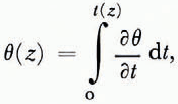The Editor,
Journal of Glaciology
Sir,
While drilling the deep bore hole at Byrd Station during the Antarctic summer of 1967–68 it was found that the drill showed a persistent tendency to wander from the true vertical (Reference Ueda and GarfieldUeda and Garfield, 1969). Efforts were made to correct the deviation : drilling rate was reduced, shorter cores were taken, and the drill was centred more exactly, but by the time the drill had reached bedrock at 2152.8 m depth the drill was displaced horizontally by 268 m relative to its point of entry at the surface and was inclined at an angle of 15° from the vertical. The deviation is shown in Figure 1 in the form of north and east displacements against depth below the surface. At the time, the deviation was assumed to be of random origin and amplified by a natural instability of the drill. However, the hole was resurveyed in 1975 to determine the horizontal ice velocity as a function of depth (Reference Garfield and UedaGarfield and Ueda, 1976), and these authors suggest that the hole had moved in such a way that its deformation might provide a possible explanation for the original deviation while drilling. They mention that a similar phenomenon was noted by B. L. Hansen in the drill hole at Camp Century, Greenland. I have made a simple calculation to see whether this is plausible.

Fig. 1. North and east components of displacement of the drill at Byrd Station, Antarctica, as it deviated during drilling, 1967-68. (Data from Garfield and Ueda (1976).)
Let us consider the expected deviation of a drill in a shear-straining ice mass (Fig. 2). A drill of length l descends at constant vertical speed v through an ice mass in which the horizontal ice velocity u(z) is a function of depth z. We measure ice velocities relative to the surface. Let the angle of inclination of the drill at depth z be θ. Now if u(z) varies with depth there is a difference in velocity between the top and bottom of the drill, leading to a change of θ with time t; it is this rotation which could account for the drill deviation. For small θ we have


Fig. 2. Model for the deviation of a drill in a shear straining ice mass.
If the drill begins perfectly plumb at the surface, with θ = 0, then at depth z we have

where t(z) is the time taken to reach depth z. But
so

The displacement relative to the surface is then

The integral can be performed numerically using the data for the Byrd bore hole, and for the present purpose I have simply taken these from figures 4 and 5 in Reference Garfield and UedaGarfield and Ueda (1976). The predicted displacement of the drill while drilling can then be calculated by supplying a value for the vertical speed of the drill. Figure 3 shows the result calculated using the actual drill speed, and this should be compared with the observed deviation shown in Figure 1. The calculation has only been made down to depth 1474 m, since beyond this point the hole was inaccessible for remeasurement. As can be seen, there is a striking similarity of form between the real and the expected deviation. However, the disturbing thing is that there is a radical disagreement in magnitude; actual deviations are about 103 greater than those expected on the model presented. We can only obtain quantitative agreement if we use an absurdly slow value for the drill speed : a speed of 7.8 m a-1 gives a good fit, while the actual speed averaged 21 m d-1, a rate of 7.8 × 103 m a-1.

Fig. 3. Predicted drill deviation for the Byrd bore hole. The dashed line is simply a linear extrapolation, as the hole was inaccessible beneath 1474 m depth.
What is the reason for the disagreement ? The similarity of form suggests that there is certainly a connection between ice shear strain and drill deviation, but the gross disparity in magnitude suggests that the mechanism proposed is incorrect or aided by other mechanisms. It is at first tempting to attribute the large deviation to an instability of drill direction due to its design : the drill was 26.5 m long and had an effective working weight of about 400 kg with a centre of gravity well above the cutting edge. Any small deflection of the drill from the vertical will therefore result in a turning moment of the weight of the drill about its end, which should amplify the deflection and mean that, once established, any small deviation should continue growing and would not reverse in response to the reverses in the sense of the vertical shear strain-rate. This contradicts the fact that the north component of drill displacement shows two inflexions with depth, and that the east component of displacement remains approximately linear below 1000 m depth, with no further amplification.
Can anyone explain why the mechanism I propose, which is the obvious one, should give such good agreement in form, but such gross disagreement in magnitude?





